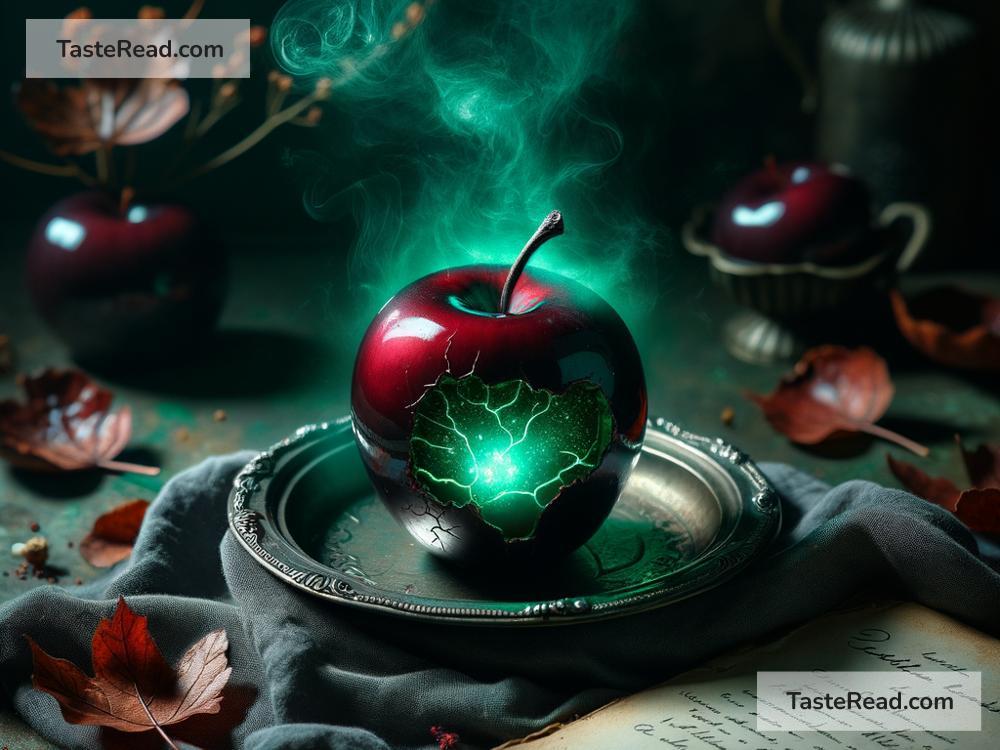The Tale of the Cursed Candy Apple
Once upon a time, in a small village surrounded by dense forests and rolling hills, there was a famous annual harvest festival. Every year, villagers would gather to celebrate the changing of seasons with music, dancing, and delicious food. One treat everyone loved was the candy apples—fresh, juicy apples coated in sticky caramel, often topped with sprinkles or chopped nuts. Kids and adults alike lined up for their chance to grab one.
But one year, something strange happened. A lone woman appeared at the festival handing out free candy apples. She wasn’t a familiar face in the village, and many whispered about her odd appearance. She wore a flowing black dress, a crooked hat, and had long silvery hair that glowed faintly in the moonlight. Her smile seemed both kind and unsettling, and her eyes seemed to shine with an unplaceable, mysterious light.
Still, most villagers didn’t think much of it. Free candy apples were hard to resist, and people eagerly accepted her gift. The apples she handed out looked more perfect than any apple they’d seen before—bright red, shiny, and sweeter-smelling than anything imaginable.
But soon after the festival, strange things began happening.
A Village Changed Forever
The day after the harvest festival, the first sign of trouble appeared. A young boy named Thomas, who had excitedly eaten his candy apple, was found deep in the forest, staring at the trees. When his parents called out to him, he didn’t respond. His eyes were wide and blank, like he was lost inside a dream.
They shook him gently. “Thomas, what’s wrong?”
“They’re calling me,” he whispered. “The trees. They want me to come closer.”
His parents were terrified and rushed him home. But as the days passed, more villagers who had eaten the mysterious candy apples began behaving strangely. Farmers stopped tending their crops and wandered into the woods without explanation. Children grew unusually quiet, staring out of windows like they were waiting for something. Even the village baker closed his shop because flour suddenly tasted “wrong” to him.
Every affected person seemed to hear a strange call—a whisper carried on the wind, urging them closer to the woods that bordered their village. The once-lively village grew eerily silent. Those who hadn’t eaten the candy apples began to worry. What was happening to their friends and family?
A Mystery Unraveled
Fearing for her village’s safety, the mayor, an elderly woman named Margaret, decided to investigate. She gathered a small group of villagers who hadn’t eaten the candy apples and ventured into the forest, hoping to find answers.
The deeper they went, the more bizarre things became. Trees seemed taller and darker than usual, their twisted branches forming strange shapes overhead. Glowing mushrooms dotted the ground, and the air felt thick, almost humming with an invisible force.
At the center of the forest, they found something chilling. On a moss-covered stone sat a single candy apple, perfectly untouched. Around it, villagers who had disappeared earlier were sitting or lying on the ground. They weren’t hurt, but they looked trapped in some kind of trance. Their lips moved as if they were speaking, yet no sound escaped.
Margaret’s group whispered among themselves. “What is this place?” one villager asked. “And how did they end up here?”
“That woman from the festival,” Margaret said grimly, “she wasn’t ordinary. The candy apples must have been cursed.”
The Curse of the Candy Apple
Suddenly, the air grew cold, and the mysterious woman appeared. Her eyes glowed brighter than before, and her smile was sharper. She faced Margaret and her group.
“Why have you come here?” she asked. Her voice was smooth but carried an eerie echo.
Margaret stepped forward bravely. “You’ve brought harm to our village,” she said. “What have you done to our people?”
The woman tilted her head, amused. “The apples are only cursed because of your greed,” she said. “You all accepted gifts without gratitude, taking without thinking about the cost. That is the curse.”
Margaret frowned, but she didn’t back down. “Then lift the curse. Tell us how to free them.”
The woman paused, then handed Margaret the untouched candy apple from the stone. “This apple holds the key. If someone eats it willingly, knowing the risks, the curse will break—but that person will pay the price in their own way.”
Margaret’s heart sank. What did “pay the price” mean? She didn’t know, but she couldn’t let her village suffer any longer. Without hesitation, she bit into the candy apple.
The Price of Kindness
As Margaret swallowed the last bite, the villagers trapped in the forest began to stir. Their eyes cleared, and their trances ended. Everyone returned to the village, safe but confused. They didn’t remember much about what had happened, and the whispers from the forest disappeared.
But Margaret was never the same. Slowly, she began to age faster than normal. Her hair turned gray, her skin wrinkled, and her energy faded. While she remained kind and wise, she became frail and weak in the years after. People whispered that she had sacrificed her youth to save them all.
From that day forward, the villagers learned to be cautious with gifts. Every harvest festival, they remembered Margaret’s bravery—and the danger of the cursed candy apple.
A Lesson in Gratitude
The tale of the cursed candy apple became a legend passed down through generations. It reminded people to treasure their blessings and to be mindful of their choices. Sometimes, things that look sweet and harmless carry hidden consequences. And sometimes, the greatest acts of kindness require the greatest sacrifices.
Next time you see a glistening candy apple, take a moment to wonder: is it just a treat, or is there something more hiding beneath the caramel?
Would you take a bite?


